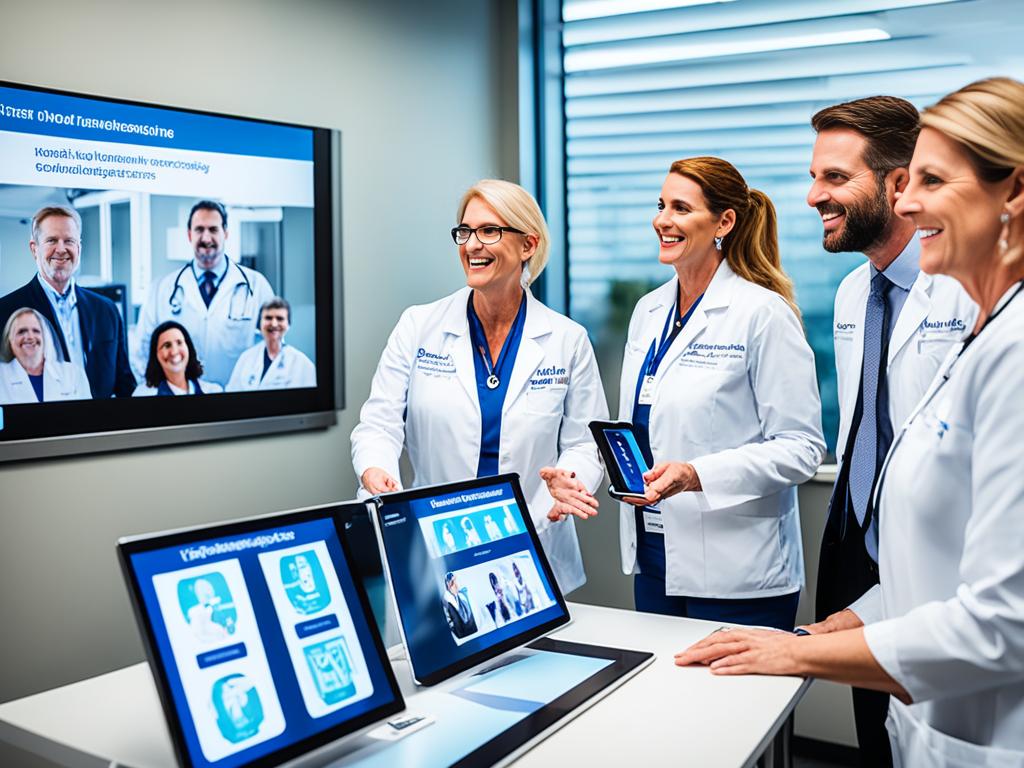Healthcare management and administration plays a vital role in driving the growth and adoption of telemedicine, enabling remote patient care and streamlining operations. Healthcare managers are responsible for overseeing the integration of telemedicine technologies within healthcare organizations, ensuring effective implementation, and addressing various challenges and barriers to its widespread adoption. Their role encompasses strategic planning, resource allocation, policy development, and fostering a culture that embraces the benefits of telemedicine. By aligning telemedicine initiatives with organizational goals, healthcare managers can enhance access to care, improve patient outcomes, and optimize healthcare delivery and operations.
Key Takeaways
- Healthcare managers play a crucial role in integrating and implementing telemedicine within healthcare organizations.
- Their responsibilities include strategic planning, resource allocation, and policy development to support telemedicine initiatives.
- Aligning telemedicine with organizational goals can enhance patient access to care and improve healthcare outcomes.
- Healthcare managers must address various challenges and barriers to the widespread adoption of telemedicine.
- Fostering a culture that embraces the benefits of telemedicine is essential for its successful implementation.
Origins and Evolution of Telemedicine
The concept of telemedicine has its origins in the early developments of telecommunication technologies. The telegraph, radio, and telephone were among the first forms of communication that laid the foundation for remote healthcare delivery. Over the past fifty years, telemedicine has evolved significantly, driven by advancements in digital communications, video conferencing, medical imaging, and electronic health records.
Early Beginnings of Telecommunication in Healthcare
The ability to transfer information over long distances and the growing accessibility of computing devices have enabled healthcare providers to deliver care remotely, reaching patients in rural and underserved areas. This early adoption of telecommunication in healthcare paved the way for the emergence and growth of telemedicine as a viable means of providing medical services.
Technological Advancements Fueling Telemedicine Growth
As technology continues to evolve, new innovations in areas like artificial intelligence, virtual reality, and connected devices are further enhancing the capabilities and potential of telemedicine. These telehealth advancements have the power to transform the way healthcare is delivered, improving access to care and optimizing patient outcomes.
Current Impact and Utilization of Telemedicine
The COVID-19 pandemic has undoubtedly accelerated the widespread adoption and utilization of telemedicine. As healthcare providers sought to minimize in-person contact and continue serving patients remotely, telemedicine emerged as a vital tool for delivering essential care, including chronic disease management, mental health services, and routine consultations. This surge in telemedicine utilization has demonstrated its significant impact on healthcare delivery, transforming the way care is accessible to patients.
Telemedicine during the COVID-19 Pandemic
During the height of the COVID-19 crisis, telemedicine became a crucial lifeline for healthcare providers to connect with patients and maintain continuity of care. By leveraging virtual platforms, doctors, nurses, and other healthcare professionals were able to conduct remote consultations, monitor patients’ conditions, and provide necessary treatments without exposing vulnerable individuals to the risk of in-person visits. This adaptability and responsiveness of telemedicine have been instrumental in ensuring that patients, particularly those with chronic illnesses or limited mobility, could continue receiving the care they needed during the pandemic.
Affordability and Cost-Effectiveness of Telemedicine Services
In addition to its impact on patient access, telemedicine has also demonstrated its cost-effectiveness for both healthcare providers and patients. By reducing the need for travel, minimizing wait times, and streamlining administrative processes, telemedicine services have become a more affordable alternative to traditional in-person visits. This increased affordability has made telemedicine especially beneficial for individuals in rural and underserved areas, who may have faced financial and logistical barriers to accessing healthcare. As the healthcare industry continues to navigate the challenges of rising costs, the cost-effectiveness of telemedicine solutions has become a crucial factor in driving their widespread adoption and utilization.

Integration of Telemedicine with Artificial Intelligence
The integration of telemedicine with emerging technologies, such as artificial intelligence (AI) and virtual reality (VR), is revolutionizing the way healthcare is delivered remotely. AI-powered telemedicine applications are transforming the landscape, empowering healthcare providers with advanced capabilities that enhance clinical decision-making, streamline workflows, and deliver more personalized patient care.
AI-Powered Telemedicine Applications
AI-based telemedicine solutions are driving remarkable advancements in the field. These cutting-edge applications can assist healthcare providers in a variety of tasks, including automated data analysis, disease diagnosis, and personalized treatment recommendations. By leveraging the power of AI, telemedicine services can now provide more accurate and efficient clinical decision support, ultimately leading to improved patient outcomes.
Virtual Reality in Telemedicine
Alongside the integration of AI, virtual reality (VR) technology is also making strides in the telemedicine domain. VR-enabled telemedicine allows for the creation of immersive experiences, enabling virtual consultations, remote surgical planning, and enhanced patient engagement. This innovative approach to telemedicine can improve collaboration between healthcare providers, facilitate remote training and education, and offer patients a more engaging and interactive healthcare experience.
By seamlessly integrating telemedicine with AI and VR, healthcare organizations can unlock new possibilities in remote patient care. These advanced technologies can enhance clinical decision-making, streamline workflows, and deliver a more comprehensive and personalized patient-centered care experience, ultimately transforming the future of telemedicine.
Healthcare Management and Administration
Healthcare management and administration play a crucial role in the successful implementation and adoption of telemedicine practices. Healthcare managers are responsible for strategic planning, resource allocation, and policy development to ensure the effective integration of telemedicine technologies within their organizations.
Roles of Healthcare Managers in Telemedicine Implementation
Healthcare managers must address various challenges and barriers, such as regulatory compliance, reimbursement policies, privacy and security concerns, and organizational resistance to change. By aligning telemedicine initiatives with the organization’s goals and fostering a culture that embraces the benefits of telemedicine, healthcare managers can drive the widespread adoption of these technologies.
Overcoming Barriers and Challenges in Telemedicine Adoption
Healthcare managers play a crucial role in overcoming the barriers and challenges associated with telemedicine adoption. They must ensure compliance with evolving regulations, navigate reimbursement policies, and address privacy and security concerns to build trust and confidence among healthcare providers and patients. Additionally, they must manage organizational resistance to change by implementing effective change management strategies and promoting the advantages of telemedicine.
By leveraging their expertise in healthcare management and administration, healthcare managers can ultimately improve access to care, enhance patient outcomes, and optimize healthcare delivery and operations through the successful implementation and adoption of telemedicine.
Telemedicine in Rural and Underserved Areas
Telemedicine has a significant impact on improving access to healthcare services in rural and underserved areas. By enabling remote consultations and eliminating the need for patients to travel long distances to access specialized care, telemedicine helps bridge the gap in healthcare services for communities that traditionally have limited access.
Improving Access to Healthcare Services
The integration of telemedicine technologies in rural and underserved regions has transformed the healthcare landscape, making it easier for patients to receive the care they need without the burden of traveling. Patients in these areas now have the ability to consult with healthcare providers remotely, accessing a wider range of medical services and reducing the time and expense associated with seeking care. This improved access to healthcare services can lead to earlier diagnosis, more consistent disease management, and better overall health outcomes for individuals in these communities.
Fostering Trust in Local Healthcare Systems
In addition to improving access, telemedicine can also help foster trust in local healthcare systems. By enabling patients to receive high-quality care without having to leave their communities, telemedicine helps build confidence in the local healthcare infrastructure. This increased trust and accessibility can lead to improved patient engagement, better health outcomes, and more sustainable local healthcare systems that are responsive to the needs of the community.

Regulatory and Legal Considerations
The successful implementation of telemedicine requires healthcare managers to navigate a complex landscape of regulatory and legal considerations. Ensuring compliance with various laws and regulations, such as those governing telehealth reimbursement policies and guidelines, is a critical responsibility for healthcare managers. Additionally, they must address patient privacy and security concerns to protect sensitive healthcare data and maintain the trust of both patients and providers.
Telehealth Reimbursement Policies and Guidelines
Navigating the evolving landscape of telehealth reimbursement is a key priority for healthcare managers. They must stay up-to-date with the latest policies and guidelines set forth by government agencies, private insurers, and other regulatory bodies to ensure that their telemedicine services are properly reimbursed. This includes understanding coverage limitations, billing codes, and documentation requirements to maximize the financial viability of their telemedicine initiatives.
Privacy and Security Concerns in Telemedicine
Addressing patient privacy and security concerns is essential for building trust and confidence in telemedicine services. Healthcare managers must implement robust data protection measures, such as encryption, secure communication channels, and strict access controls, to safeguard patient information. They must also ensure compliance with telemedicine regulations and legal frameworks, such as the Health Insurance Portability and Accountability Act (HIPAA), to maintain the confidentiality and integrity of healthcare data.
| Regulatory and Legal Considerations in Telemedicine | Key Factors |
|---|---|
| Telehealth Reimbursement Policies and Guidelines |
|
| Patient Privacy and Security Concerns |
|
By addressing these regulatory and legal considerations, healthcare managers can ensure the successful and sustainable implementation of telemedicine, while upholding the trust and confidence of patients and healthcare providers.
Telemedicine Training and Education
Effective telemedicine implementation requires the development of telemedicine-specific competencies for healthcare professionals. Healthcare managers must ensure that their teams are well-trained and equipped to utilize telemedicine technologies, engage with patients remotely, and provide high-quality care through virtual platforms. This includes training on technical aspects, patient-centered communication, and the integration of telemedicine into existing workflows. Investing in ongoing education and skills development for healthcare professionals is essential for ensuring the successful adoption and effective delivery of telemedicine services.
Developing Telemedicine Competencies for Healthcare Professionals
To ensure the successful implementation of telemedicine training and telemedicine education, healthcare managers must focus on developing telemedicine-specific competencies for their healthcare professionals. This includes training on the technical aspects of telemedicine technologies, such as operating video conferencing platforms, accessing electronic health records, and utilizing remote monitoring devices. Additionally, healthcare professionals must be trained on effective patient-centered communication strategies to engage with patients remotely and maintain the same level of care and empathy as in-person interactions.
Furthermore, healthcare professionals must be equipped with the knowledge and skills to seamlessly integrate telemedicine services into their existing workflows. This involves training on appointment scheduling, documentation, and coordination with other members of the healthcare team. By investing in comprehensive telemedicine training and education, healthcare managers can ensure that their teams are well-prepared to deliver high-quality telemedicine-based healthcare services.

Ongoing professional development and skills enhancement are crucial for maintaining healthcare professionals’ telemedicine competencies. As telemedicine technologies and best practices continue to evolve, healthcare managers must provide their teams with opportunities for continuous learning and skill refinement. This may include regular training sessions, webinars, or access to online resources and communities of practice. By fostering a culture of lifelong learning, healthcare managers can empower their teams to stay at the forefront of telemedicine advancements and deliver the best possible care to their patients.
Patient-Centered Telemedicine Approaches
Telemedicine practices must be designed with a strong focus on patient-centered care to ensure a positive and engaging experience for patients. Healthcare managers play a crucial role in prioritizing the patient experience by addressing factors such as user-friendly interfaces, seamless appointment scheduling, and clear communication.
Enhancing the Patient Experience
Healthcare managers must strive to enhance the patient-centered telemedicine experience by emphasizing factors that directly impact patient satisfaction and engagement. This includes investing in intuitive and accessible technology platforms, streamlining the appointment booking process, and fostering clear and transparent communication between patients and healthcare providers. By addressing these essential elements, healthcare managers can improve patient experience and build trust in telemedicine services.
Health Literacy and Clear Communication in Telemedicine
In addition to enhancing the overall patient experience, healthcare managers must consider health literacy and ensure that telemedicine services are accessible and understandable for patients of diverse backgrounds and capabilities. This involves promoting clear communication, using plain language, and providing educational resources to help patients navigate and engage effectively with telemedicine platforms. By prioritizing clear communication in telemedicine, healthcare managers can empower patients to actively participate in their care and make informed decisions.

By fostering a patient-centered approach and promoting clear communication, healthcare managers can build trust, improve patient satisfaction, and optimize the overall effectiveness of telemedicine. This holistic focus on the patient experience is crucial for the successful adoption and long-term success of telemedicine within the healthcare system.
Future Trends and Advancements in Telemedicine
As the healthcare industry continues to evolve, healthcare managers must stay informed about the emerging trends and advancements that are shaping the future of telemedicine. Innovations in areas such as artificial intelligence, virtual reality, and connected devices are poised to further enhance the capabilities and reach of telemedicine services.
Emerging Technologies in Telemedicine
The integration of artificial intelligence (AI) into telemedicine applications is revolutionizing the way healthcare providers can analyze patient data, assist in disease diagnosis, and personalize treatment recommendations. Additionally, the incorporation of virtual reality (VR) technology is enabling more immersive patient experiences, from virtual consultations to remote surgical planning. Furthermore, the proliferation of connected devices, such as remote patient monitoring tools, is empowering patients to take a more active role in their healthcare while providing healthcare teams with valuable real-time data.
Fostering Collaboration and Interdisciplinary Teamwork
To fully capitalize on the potential of telemedicine, healthcare managers must foster a culture of collaboration and interdisciplinary teamwork. By bringing together experts from various healthcare disciplines, including physicians, nurses, therapists, and IT specialists, organizations can leverage a diverse range of expertise to deliver more comprehensive and personalized telemedicine services. This collaborative approach not only enhances the patient experience but also promotes innovative solutions that cater to the unique needs of individual patients and communities.
As healthcare managers navigate the evolving landscape of telemedicine, staying attuned to these emerging trends and advancements will be crucial in positioning their organizations for continued success. By embracing new technologies and collaborative models, they can ensure that their telemedicine initiatives remain at the forefront of healthcare delivery, driving improved access to care, enhanced patient outcomes, and optimized healthcare operations.
Conclusion
In conclusion, healthcare management and administration play a pivotal role in driving the growth and adoption of telemedicine practices. From strategic planning and policy development to addressing regulatory and legal considerations, healthcare managers are responsible for ensuring the successful integration of telemedicine within their organizations. By leveraging emerging technologies, fostering patient-centered approaches, and promoting interdisciplinary collaboration, healthcare managers can harness the full potential of telemedicine to improve access to care, enhance patient outcomes, and optimize healthcare delivery.
As the healthcare landscape continues to evolve, the role of healthcare managers in advancing telemedicine will become increasingly crucial in shaping the future of remote patient care. By staying attuned to emerging trends and advancements in the field, healthcare managers can position their organizations to deliver increasingly effective and efficient telemedicine services, ultimately transforming the way healthcare is delivered and improving overall patient outcomes.
The successful implementation of telemedicine in healthcare management requires a multifaceted approach that addresses the various challenges and barriers to its widespread adoption. By addressing regulatory and legal considerations, ensuring patient privacy and security, and promoting the development of telemedicine-specific competencies among healthcare professionals, healthcare managers can drive the successful integration of these technologies within their organizations.
FAQ
What is the role of healthcare managers in advancing telemedicine practices?
How has telemedicine evolved over time?
How has telemedicine impacted healthcare delivery during the COVID-19 pandemic?
How is telemedicine being integrated with emerging technologies like artificial intelligence and virtual reality?
What are the key responsibilities of healthcare managers in implementing and adopting telemedicine?
How does telemedicine improve access to healthcare in rural and underserved areas?
What are the regulatory and legal considerations surrounding telemedicine?
How do healthcare managers ensure the development of telemedicine-specific competencies for healthcare professionals?
How do healthcare managers ensure a patient-centered approach to telemedicine?
What are the future trends and advancements in telemedicine?
Source Links
- https://www.ncbi.nlm.nih.gov/pmc/articles/PMC10045599/
- https://www.ncbi.nlm.nih.gov/pmc/articles/PMC8499808/
- https://www.linkedin.com/pulse/telemedicine-when-used-healthcare-management-medleymedicine

